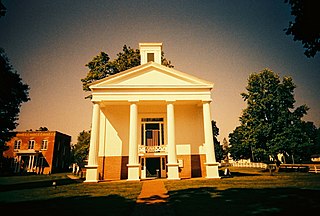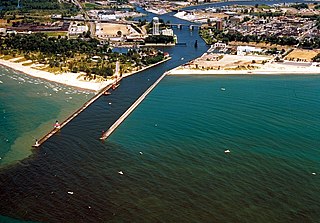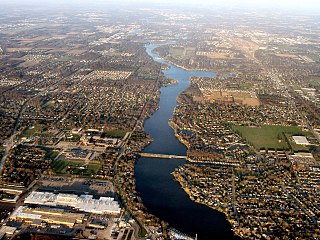Related Research Articles

Berrien County is a county on the south line of Michigan, at the southwestern corner of the state. As of the 2010 census, the population was 156,813. The county seat is St. Joseph.

Benton Harbor is a city in Berrien County in the U.S. state of Michigan which is forty-six miles southwest of Kalamazoo, and seventy-one miles southwest of Grand Rapids. In 2010, the population was 10,038 according to the census. It is the smaller, by population, of the two principal cities in the Niles–Benton Harbor Metropolitan Statistical Area, an area with 156,813 people.

St. Joseph is a city in the U.S. state of Michigan. It was incorporated as a village in 1834 and as a city in 1891. As of the 2010 census, the city population was 8,365. It lies on the shore of Lake Michigan, at the mouth of the St. Joseph River, about 90 miles (140 km) east-northeast of Chicago. It is the county seat of Berrien County. It is home of the American Society of Agricultural and Biological Engineers.

Michiana is a region in northern Indiana and southwestern Michigan centered on the city of South Bend, Indiana. The Chamber of Commerce of St. Joseph County, Indiana defines Michiana as St. Joseph County and "counties that contribute at least 500 inbound commuting workers to St. Joseph County daily." Those counties include Elkhart, La Porte, Marshall, St. Joseph, and Starke in Indiana, and Berrien and Cass in Michigan. As of the 2010 census, the population of those seven counties was 856,377.
The St. Joseph Valley Parkway is a freeway in the U.S. states of Indiana and Michigan, serving as a bypass route around Elkhart, Mishawaka, and South Bend in Indiana and Niles in Michigan. The freeway runs to the south and west of Elkhart and South Bend and Niles and consists of segments of U.S. Route 31 (US 31) and US 20; those two highway designations run concurrently at the southwestern rim of the South Bend metropolitan area. It continues north to run along the St. Joseph River valley.

The St. Joseph River is a 206 miles (332 km) long tributary of Lake Michigan flowing generally westerly through southern Michigan and northern Indiana, United States, to its terminus on the southeast shore of the lake. It drains a primarily rural farming area in the watershed of Lake Michigan. It was enormously important to Native Americans and greatly aided in the colonial exploration, settlement and administration of New France and the nascent United States as a canoe route between Lake Michigan and the watershed of the Mississippi River.

The Harbor Springs Railway was a 2 ft 6 in narrow gauge railway built at Harbor Springs, Michigan on Little Traverse Bay on Lake Michigan. It was nicknamed the Hemlock Central because of the great numbers of hemlock trees growing in the area. The railway was chartered by Ephraim Shay, the inventor of the Shay locomotive, on February 2, 1902, but may have started construction as early as December 10, 1900.
M-139 is a state trunkline highway entirely within Berrien County in the US state of Michigan. The highway starts at US Highway 12 (US 12) southwest of Niles and runs through rural areas of the county to terminate at an intersection with Business Loop Interstate 94 in Benton Harbor. The highway runs parallel to the St. Joseph River, crossing the river several times as it follows a set of roads previously used for US 31 in the area. The highway was first designated in the 1930s as a bypass of the Benton Harbor and St. Joseph area. Its termini have been moved over the years since, extending and contracting the length of the highway between Niles and Benton Harbor. M-139 now serves to provide access through the area from a set of bypasses consisting of I-94 and US 31.
The Saginaw and Mount Pleasant Railroad was a wholly owned subsidiary of the Flint and Pere Marquette Railroad (F&PM). It was established to construct a 14.7-mile (23.7 km) railway line from a junction with the F&PM main line at Coleman, Michigan, to Mount Pleasant, Michigan. The line opened on December 15, 1879, as a 3 ft narrow gauge line. In mid-1884 the line was converted to 4 ft 8 1⁄2 instandard gauge. On January 31, 1889 the company was formally merged into the F&PM along with the East Saginaw and St. Clair Railroad, the Saginaw and Clare County Railroad, and the Manistee Railroad.
The Flint and Pere Marquette Railroad (F&PM) is a defunct railroad which operated in the U.S. state of Michigan between 1857 and 1899. It was one of the three companies which merged to become the Pere Marquette Railway.
The Detroit, Lansing and Northern Railroad (DL&N) is a defunct railroad which was formed on December 27, 1876 as a reorganization of the foreclosed Detroit, Lansing and Lake Michigan Rail Road. The segment of its main line from Detroit to Lansing became an important component of the Pere Marquette Railroad, organized in 1900, and is still in use by CSX.
The Chicago and West Michigan Railway (C&WM) is a defunct railroad which operated in the state of Michigan between 1881 and 1899. It was one of the three companies which merged to become the Pere Marquette Railway.
The Paw Paw Railroad is a defunct railroad which operated in Van Buren County, Michigan, between 1857 and 1887. At a length of 4 miles (6.4 km), it was the shortest operating common carrier railroad in the state. Later, the Ludington & Northern Railway Company, at 2.79 miles (4.49 km), stripped the Paw Paw of its title as "shortest Michigan Railroad".
The Grand Rapids, Kalkaska and Southeastern Railroad is a defunct railroad which operated in Northern Michigan toward the end of the 19th century. The company was founded on August 30, 1897 by William Alden Smith, a Republican politician and former general counsel of both the Chicago and West Michigan Railway and the Detroit, Lansing and Northern Railroad. The GRK&S constructed a 40.73-mile (65.55 km) line from northern Missaukee County through Kalkaska to Rapid City, where it met the C&WM's main line. The C&WM undertook to supply rolling stock and oversee construction in exchange for a 10-year lease of the line.
The above shows the physical line of the Michigan and Ohio as of March 25, 1887, when the Cincinnati, Jackson & Mackinaw bought it, including crossings by other lines as they were then constituted. Intermediate stations omitted. The Michigan and Ohio Railroad is a defunct railroad which operated in southern Michigan in the mid-1880s. Originally intended to forge a new line from Lake Erie to Lake Michigan, it came close to its goal, completing a line between Allegan and Dundee before financial embarrassment landed it in receivership.

The St. Joseph Valley Rail Road is a defunct railroad which operated in southern Michigan during the mid-19th century.
There have been several railroads named for the St. Joseph Valley in southern Michigan and northern Indiana:
The Leelanau Transit Company was a short line standard gauge railroad incorporated in 1919 as the successor to the Traverse City, Leelanau, and Manistique Railroad, which was incorporated in 1901 to build a line from Traverse City, Michigan to Northport, Michigan in order to support a carferry service to Manistique on the Upper Peninsula. This line was a project of the Grand Rapids and Indiana Railroad and completed a connection from Northport to the main north-south line at Walton Junction via the Traverse City Rail Road Company; unlike the latter, however, it was never folded into the parent company.
The Kalamazoo and White Pigeon Railroad (K&WP) was a shortline railroad in the U.S. state of Michigan. The line ran from Lansing to Jonesville, then returned north from Jonesville to Albion and Eaton Rapids before closing the loop in Lansing. The NCMR had a short life as an independent company, becoming part of the Lake Shore and Michigan Southern Railway in 1871 and then consolidating with the New York Central Railroad in 1914.
References
- Hilton, George Woodman (1990). American Narrow Gauge Railroads. Stanford University Press. ISBN 0-8047-1731-1.
- Meints, Graydon M. (2005). Michigan Railroad Lines. East Lansing, Michigan: Michigan State University Press. ISBN 978-0-87013-693-1.
- Michigan Railroad Commission (1887). Annual Report.
- Myers, Robert (January–February 1988). "The St. Joseph Valley Railroad Company". Michigan History. 72 (1): 24–30.